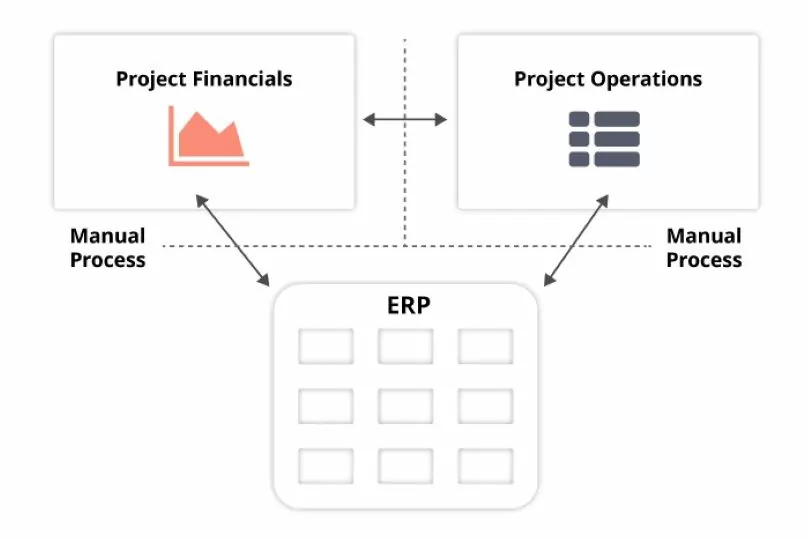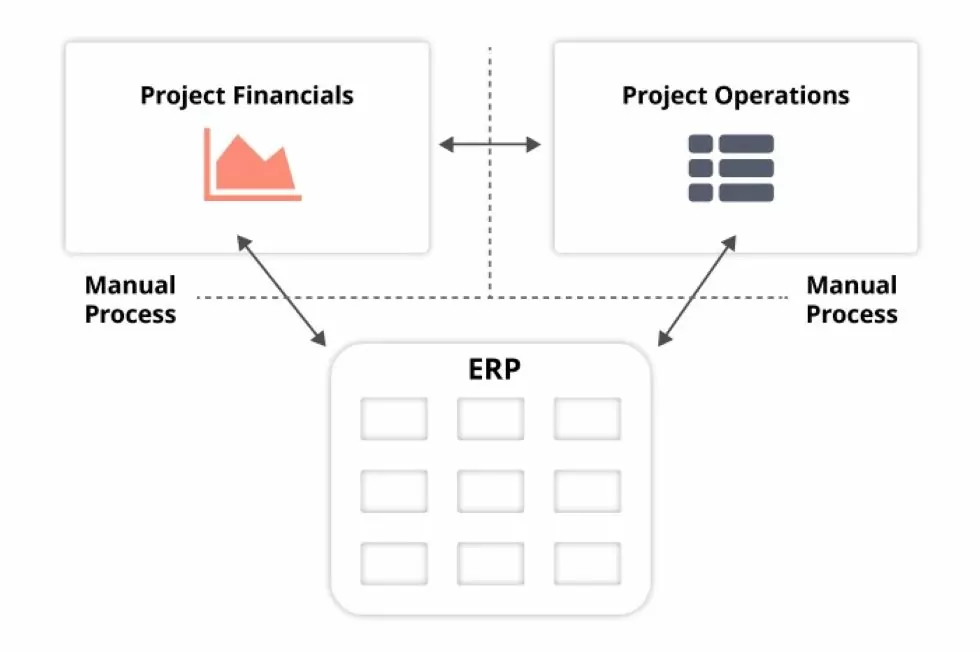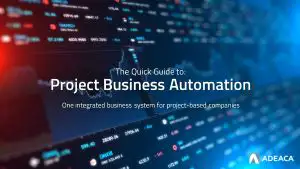Having been involved in designing major ERP systems for more than 30 years, it still surprises me how much project industries are stuck in the early 1990s, in a pre-internet era. By project industries, I mean companies that are project oriented in nature, which includes everything from professional services to engineering/construction to ETO type manufacturing. About 20% of all companies organize their activities in projects.
While all other industries now run their core business fully inside an ERP system and reap the benefits of all departments working together in real time, project industries are still stuck using a hodgepodge of disparate custom systems and desktop office applications to manage their sometimes billion-dollar businesses. Operational and financial departments remain completely separated and are only loosely interwoven with error-prone manual processes.
This setup presents an everyday struggle for top management. It is increasingly difficult to make the best decisions for their companies because nobody can provide them with timely data on critical projects.
As a result, project companies are not performing as well as they could. The sad thing is they seem complacent with it and even resigned to the lack of innovation. Plus, most major ERP vendors are content to let it stay that way. Why complicate good business with unnecessary innovation when nobody rocks the boat?
Enter ADEACA. We have worked hard the last 10 years reengineering business processes necessary for a modern ERP to run project business at its core. Integrating both project operations and project financials into a fully process governed enterprise wide ERP system, with no other applications or desktop tools necessary. We’ve gone so far as to coin a new category of enterprise solutions that strive to accomplish this feat. We call it Project Business Automation, and ADEACA ONE is the first to fill this category.
But before I get ahead of myself, let’s start from the beginning.
The Fundamental Flaw
As a project-driven company, projects are the center of your business. However, traditionally you run project management and project financial systems completely separated from the main business ERP system. The fundamental separation of what is core to your project business and your ERP solution, makes project-centered companies grind to a crawl in most cases.
Historically, ERPs are built to be the central system to run any business. However, ERPs evolved from MRPs, so they are incredibly well-suited for retailers, distributors, high-volume manufacturers, etc. But they do nothing for the 20% of all businesses that organize their business activities in projects, like construction, engineer-to-order, aerospace & defense, mining & exploration, and professional services. For these companies, projects are their life, and the functionality found inside typical ERPs is completely useless, relegating ERPs to general ledger accounting software for most of these companies instead of the enterprise-wide automated business system it was promised to be. Therefore, project-based companies are typically left running three separate systems.
Running projects outside the ERP requires that you somehow connect the range of tools, desktop application and/or systems. These “connections” are tenuous at best and typically require spreadsheets with manual and cumbersome processes to make it all “work”.

Although this diagram is simplistic, it illustrates the fundamental flaw of separation between systems and tools. This setup results in three major problems:
- Delays – separate systems must be integrated in some fashion. Whether that is through batch overnight processing or spreadsheet uploads, there is going to be a delay from when changes occur in the projects on the ground to when they are reflected throughout the enterprise financially. Additionally, it may require manual labor in the form of controllers reconciling data between the two systems. Delays of two weeks, a month or more are typical. You cannot compete in the Real-Time Economy with this modus operandi. This type of delay should be unacceptable to any executive in these companies.
- Errors – Introducing spreadsheets and manual reconciliation processes into the process inevitably results in errors and the fact-finding mission you have to embark upon once these errors are uncovered. This only leads to more delays and avoidable mistakes when making decisions with flawed data.
- Incomplete data – You cannot possibly reconcile every piece of data from one system to another with complete reliability. Therefore, when you want to drill down and find out more about a project, that data may just not be there. How are you supposed to make good decisions with incomplete data?
Unfortunately you cannot rely on most major ERP vendors for advice
That ERP vendors like to sell software, might not be an earth-shattering truth. And whether that software does what you really need is somewhat acedemic, as long as you can be convinced it does. That is why they “advise” project-based companies to continue to stay with their project tools running outside their ERP, selling them the least complicated solution, from a selling point of view. The vendors don’t want to complicate their own sales cycle by introducing any innovative solutions into the mix, if not forced to, and most times they don’t bring it up because they cannot provide any.
In fact, ask any of the major ERP vendors to show you how logging a change order is reflected instantly across your payment plan, WBS planning, procurement activities, capacity profiles, EAC (estimate at completion) and cashflow projections. They can’t.
The fact is that their generic ERP fits 80% of companies quite well. But for the remaining 20% that are project-based, you need something different.
The major ERP vendors don’t care about this fact. That is why projects have remained an ancillary application for the last 30 years. Major ERP vendors have invested very little in your needs as a project-based company. They advise you to keep projects separate because they can’t support your core business inside the ERP themselves.
Therefore, as a project-based company you must do your own homework and find a solution that really support your project business.
Customers are not without fault either
Customers are not completely innocent in this either. Most customers are complacent in the “business-as-usual” attitude. They think that these big ERP vendors must know what they are talking about, and if the solution costs so much, surely it will work. Many rely too much on these major ERP vendors without researching alternatives for project-based companies. However, after implementation and perhaps years of customizations, you find out that these systems just don’t work. You still have the delays and errors for which you thought you were solving.
A Better Way Forward – Project Business Automation
The point of this post is to simply help you understand the fundamental problem for project-based companies today when it comes to their systems, and to let you know that there is a better way. You need to ask your ERP vendors to bring projects to the center of ERP, unify all major functional areas of running a project business into one enterprise solution.
For that last 10 years, ADEACA has been innovating exclusively for project-driven companies. The results are found in ADEACA ONE Project Business Automation, which brings all aspects of projects to the center of a Tier-1 ERP system, Microsoft Dynamics 365. ADEACA ONE ties all enterprise project disciplines closely together in one cloud-based system, unlike anything you have seen before.
You will see project financials and operations working in tandem in real time. You gain instant visibility and insight into your project portfolio, with plans, capacity profiles, estimates-at-completion (EAC) and cashflow projections at your fingertips.
Bringing all aspects of your projects into one central place gives you much greater control over your portfolio and your company, helping you react in real-time to changing conditions, instead of weeks or month too late.
It’s our humble goal at ADEACA to transform project industries and bring them into the modern, real-time world, on par with all other industries.
Want to see what transformation looks like? Take a look at these leading project-centric companies that already have begun their transformational journey with ADEACA:
> KPMG
Conclusion
Now the secret is out. There are no more excuses for project-based companies to settle. You can operate in real time. The major ERP vendors can’t hide behind their business-as-usual methods anymore either. It’s been decades since ERP was introduced with little innovation. As a project-driven company you must demand that projects be the center of your ERP. You deserve it.











